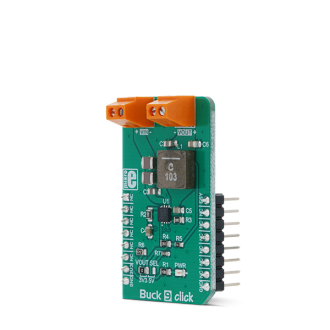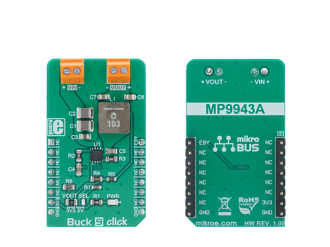
We strongly encourage users to use Package manager for sharing their code on Libstock website, because it boosts your efficiency and leaves the end user with no room for error. [more info]

Rating:
Author: MIKROE
Last Updated: 2019-03-01
Package Version: 1.0.0.0
mikroSDK Library: 1.0.0.0
Category: Buck
Downloaded: 4484 times
Not followed.
License: MIT license
Buck 9 click is a high-efficiency step-down converter which provides a highly regulated output voltage derived from the connected power source, rated from 4V to 36V.
Do you want to subscribe in order to receive notifications regarding "BUCK 9 click" changes.
Do you want to unsubscribe in order to stop receiving notifications regarding "BUCK 9 click" changes.
Do you want to report abuse regarding "BUCK 9 click".


Library Description
Library carries functions related to GPIO pins control of the Buck 9 click board. The library includes function for enable or disable device.
Key functions:
void buck9_deviceEnable(uint8_t state) - Function for enable or disable device.Examples description
The application is composed of the three sections :
Application Task - Predefined characters are inputed from the serial port. Depending on the character sent the signal frequency, waveform or amplitude will be changed.
void applicationTask()
{
buck9_deviceEnable(_BUCK9_DEVICE_ENABLE);
Delay_ms( 5000 );
buck9_deviceEnable(_BUCK9_DEVICE_DISABLE);
Delay_ms( 5000 );
}
Other mikroE Libraries used in the example:
GPIOAdditional notes and informations
Depending on the development board you are using, you may need USB UART click, USB UART 2 click or RS232 click to connect to your PC, for development systems with no UART to USB interface available on the board. The terminal available in all MikroElektronika compilers, or any other terminal application of your choice, can be used to read the message.